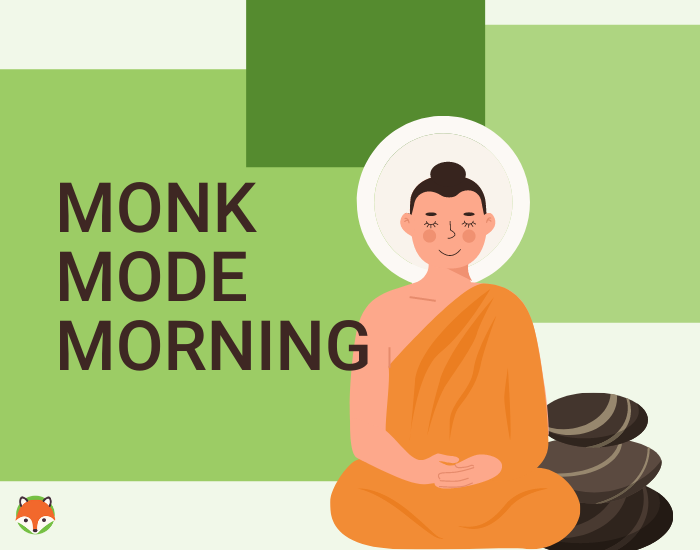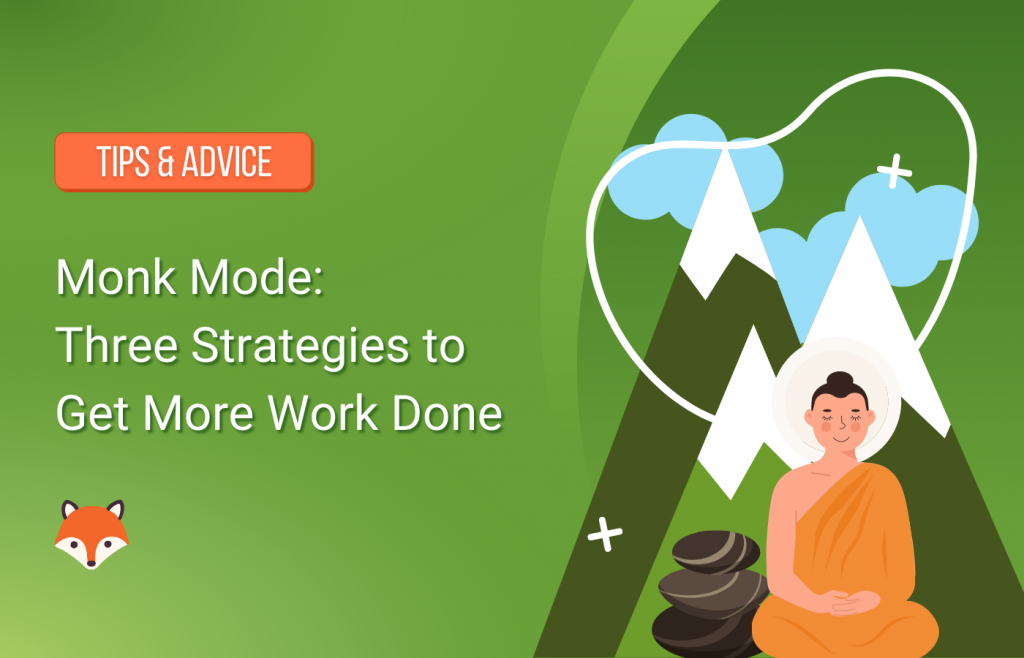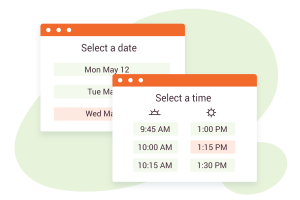We live in a modern world with so many distractions.
With the rise of technology, we endlessly browse content online or engage in non-productive conversations that eat away our time. Even with the use of time management software, we still feel at a loss for time. And, while distractions are a needed break from our busy lives, they ruin our ability to focus.
At some point, you need to channel your energy and time to important projects and abandoned goals. But how?
Enter monk mode — a period of dedicated time to a specific task or goal.
We’ll walk you through the meaning of monk mode, along with a few key strategies to help you achieve zen-like calmness in real life.
Monk Background
Before deep diving into what ‘monk mode’ means, let’s understand who’s considered a “monk”.
The word ‘monk’ is derived from the Latin word “monachus,” which means being alone. A monk is a person who voluntarily decides to isolate himself from society and embrace a solitary life. This life is characterized by severe self-discipline and abstinence from all forms of indulgence, primarily for religious reasons.
What Is Monk Mode?
Monk mode is a period of enhanced focus, discipline, and productivity where you commit yourself to completing a goal. In monk mode, you take it upon yourself to adopt the isolation and self-discipline practices of monks.
In modern times, being in a monk-like state has been made famous for self-improvement. It is described as an attempt to cope with denying ourselves of all situations and activities by gaining control of our emotional state while pursuing our goals for growth.
Why Should I Go Into Monk Mode?
If you plan to complete or get closer to any set goal, learning the strategies of monk mode can help you get a clearer understanding of how you can get there. By helping you gain a clearer mind the practice of monk mode is structured in a way to make you become a better version of yourself.
Structure of Monk Mode
The core structure of monk mode is based on three I’s:
- Introspection
- Isolation
- Improvement
Introspection is fine-tuning your focus. It means looking inwards to examine your thoughts and emotions. As a result, you learn more about yourself and who you are. It makes you identify your weaknesses and accept them.
Isolation is giving yourself some space and freedom to acknowledge your weaknesses, desires, and goals. It is separating yourself from other obligations.
Improvement is formulating a plan of action to tackle what needs to be done.
What Can You Do in Monk Mode?
Monk mode offers you the mindset and strategies to complete any goal you set out to achieve. Some people take up a monk mode challenge to abstain from something they consider a vice, like smoking, drinking alcohol, or watching TV; some choose physical goals like setting a new personal record on their fitness journey, running a marathon, or going on a mountain hike.
For others, it is academic goals like completing a certain amount of studying, reading a couple of books, and taking up an online course. The goals can be spiritual, too, where you want to meditate or pray, read scriptures, or fast for a stipulated number of hours.
Going into monk mode can also mean getting a new job, better managing your availability, making a certain amount of money, or hitting new sales quotas for financial and business goals.
Going into monk mode for work is becoming increasingly popular. But what does it mean? Let’s find out.
Meaning of Monk Mode at Work
“Monk mode is going into a hyperbolic chamber, where you can go to do a maximum amount of training in a short amount of time. It is dialing in on what’s really important and eliminating everything that’s not important so you can have the time, energy, focus, and money to really create what it is that you want.”
Gavin Speaks on YouTube
To go monk mode at work is to cut yourself from short-term activities to gain long-term growth.
The reason is that these short activities consume much of your time while yielding little to negligible increase in your market value — or, in other words, lower your productivity.
Monk mode at work helps sharpen your productivity by:
- minimizing your social time
- taking away junk activities
- stopping you from constantly refreshing social media
- preventing you from sitting around idly
How to Increase Work Productivity With Monk Mode
When you have a work target to meet, you have to be laser-focused and remove all forms of distractions that prevent you from getting to that goal.
If you read about productive people, you’ll find many of them tried monk mode at one point or another and found it helpful to fuel their productivity.
Going monk mode at work will help you get stuff done. Simple things can maximize your productive time at work, like:
- moving the location of the kettle or coffee machine,
- using internet blockers to block out your favorite social media sites for that period, and
- going into a separate room at the office to reduce social interactions with colleagues
Benefits and Downsides of Monk Mode
Monk mode can be super beneficial to drive your productivity, but it also has its downsides. Let’s take a look at the advantages and disadvantages of entering into monk mode:
Monk Mode Benefits
- Increase in mental clarity and focus
- Gives more confidence
- Increase in empathy that helps you build good and healthy relationships with others
- Greater discernment
- Improvement in your physical health
- Helps you break the chain of harmful habits by giving you opportunities to reset the patterns and behaviors you are already used to
- Creates a boost in overall happiness
- Flexible, where you only have to do what works for you.
Monk Mode Downsides
- Can be very lonely
- Isolating yourself from everyone, even if you are an introvert, can be challenging and affect your mental health
- Not always practical (a salesperson has to interact with people, being married means you can’t isolate from your family)
- Temporary; you will need a deadline before going into this state
Admittedly, monk mode is hard — and generally associated with extreme measures. But being alone is the fastest way to make real progress. It strengthens your resolve and your endurance.
Many people go into it when they feel bad about not achieving their goals, without first checking if they have the mental capacity to go all in. That’s wrong.
A good tip is to work into it gradually and find ways to boost your mood when you need it. As Arnold Swarzenegger advises, “When you start something new, take it easy. You’ve gone your whole life without it, why overburden yourself now?”
It is essential to pace yourself while going into monk mode and only take up what you can handle per time.
This is why different monk mode plans exist, to match your capacity.
How to Create a Monk Mode Plan
Monk mode is very similar to the practice of fasting, you can practice it for a short term (30 days or less) or long term. You may find that over time you become better at extending the timeframe for which you practice monk mode. That said, following extended periods can give better results.
Typically, you should aim to practice this for a minimum of 1-3 months. A monk mode plan depends on the specific goal you want to achieve and how long you think it will take you to achieve it.
Time and intensity are two factors to consider when creating this plan.
Time could be:
- Hourly: blocking out hours in a day for deep work
- Weekly: choosing some days of the week or the weekend to isolate and go monk mode
- Seasonal: picking a few months to go into monk mode and going back to normal for the rest of the year. Winter is an excellent time for this.
- Intermittently: Going off for a while, working hard to reach a significant milestone, then taking it easy for a while. If you have another project to work on, you go off again.
Intensity is how extreme you want to go. For instance, high intensity could mean cutting off all forms of socialization, while cutting off more minor activities like partying is an example of low intensity.
Typical Routine Example
A typical routine for monk mode looks like this:
“At 5 am, you wake up. You do your morning meditation, followed by some stretching
At 6:30 am, you start your daily work for 2 hours
You do a second stretching routine at 9 am
At 10 am, you meditate again
At 11 am, you go back to 2 more hours of solid work
You eat your only meal of the day (only meat is allowed) between 1 and 2 pm
From 2 to 3 pm you relax to let the food digest
At 3:30 pm, you stretch again
At 4 pm you do 2 more hours of work
You meditate at 7 pm
You go to bed at 8 pm”
Of course, you can fine-tune your ‘monk mode’ routine however you like based on your preferences and needs.
How to Do Monk Mode Right
In this section, we’ll share a few tips you can use to get the best results. Let’s take a quick look.
1. Pick a goal you want to achieve
Monk mode is a time of extreme focus.
You need to pick a high-ticket productivity goal that can only be achieved when you cut off certain aspects of your lifestyle. This could be writing a book, sending in 300 job applications, hitting a sales target, starting a new business, or getting more clients.
Try not to multitask, or do many things at once — instead, focus on a specific goal.
Keep it simple so you don’t burn out quickly.
2. Create a system for tracking your progress
Using a big calendar is perfect for this. Mark an X on the calendar for each day that passes. The physical markings help show your mind and body that what you are doing is working.
You can also measure your progress using a notes app, Google spreadsheet, or a whiteboard.
But make sure you are tracking somewhere.
Write down what you have done that day, for example, how many applications you put in, how many blog posts you’ve published, and so on. This helps to retain and maintain your focus for longer.
3. Discipline yourself
Monk mode is not easy. You have to choose to discipline yourself every day so you do not waver. Some habits are tough to break, but you have to commit to the task ahead for progress to be made.
Common habits to cut off to achieve monk-like zen are:
- Social media and gaming
- Wasteful entertainment (cable tv/movies)
- Partying and socialization
- Unhealthy eating habits
- New or unhealthy personal relationships
Since this practice is only temporary, get yourself mentally prepared to stay the course.
Monk Mode Morning
Applying the practice of monk-like focus at work is commonly referred to as Monk Mode Morning. It is a strategy for maximizing time at work by making it more productive.

Cal Newport describes its execution as, “between when you wake up and noon: no meetings, no calls, no texts, no email, no Slack, no Internet. You instead work deeply on something (or things) that matters.”
Practicing monk-like state at work every day is not very realistic, but if you can block out some time to solely focus, you can give yourself some mental space to tidy up essential tasks on your to-do lists.
Tips for Staying Productive — Monk Style
As we have mentioned in this article, monk mode is intense. It can be pretty challenging if you are doing it for the first time.
Here are some tips to help you get in and stay in the mode:
- Don’t go cold turkey. Start with the minimum, e.g., reducing your time on social media
- Block out times in your calendar to focus on monk mode and turn on the notifications
- Develop a journal practice
- Write down what you want to accomplish
- Ask yourself why to feel so drawn to short term dopamine fixes
- Reflect on your answer and make up your mind to stick to your goal
You don’t have to apply all the above tips right away. Choose your pace and make the changes steadily.
Tools to Help You Focus on Monk Mode
You can use a few different type of tools to help you hone in on your monk mode sessions.
- Get an internet blocker to block out websites you cannot resist
- Install a blocking app for your phone to help limit app usage and notifications – some phones include a Focus mode that you can customize for monk mode
- If you’re a business professional, use a scheduling tool to set a limited availability where your business clients or team can book time outside of your monk mode sessions
- Setup a timer; either use the one on your phone or use an app to help you automate this
So, Does Monk Mode Work?
The answer is yes. This works because it makes you work. It makes you productive, and you can apply that productivity to anything you want to improve on.
It’s a recommended practice if you’re looking for a drastic change in an area or if you’re looking to formulate a strategy for work.
But once it’s over, relax and recharge. Go out and have some fun to celebrate your success!



